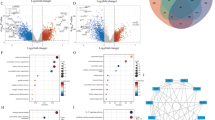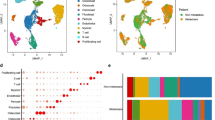Abstract
Oral squamous cell carcinoma (OSCC) is one of the most malignant diseases in the world, and the driver genes or signaling pathways remain unclear. This research integrated three OSCC microarray cohorts to screen the key candidate genes positively associated with OSCC progression. Differentially expressed genes (DEGs) were screened, and gene ontology (GO) and KEGG pathway mapping of DEGs identified enrichment in cell proliferation and cell migration procession. Moreover, the protein–protein interaction (PPI) network was constructed, and the submodules were analyzed with the Molecular Complex Detection Clustering Algorithm (MCODE). Core genes were validated and analyzed with GEPIA2, the Human protein atlas (HPA), and Gene Set Enrichment Analysis (GSEA). Fibronectin 1 (FN1) and Aurora Kinase A (AURKA) were the core genes of the two modules and interacted with each other. Further validation research demonstrated that FN1 and AURKA were highly expressed in OSCC tissues and were correlated with OSCC poor prognosis. Gene Set Enrichment Analysis (GSEA) showed that high expression of FN1 and AURKA was positively associated with the TGF-β, IL6/STAT3, and PI3K/AKT signaling pathways. Our results demonstrate that FN1 and AURKA play a central role in OSCC progression by promoting cell proliferation and migration processes and could be a diagnostic and therapeutic target for OSCC.
Highlights
-
1.
FN1 and AURKA are screened out in OSCC through PPI module analysis.
-
2.
FN1 and AURKA are highly expressed in OSCC and positively associated with poor prognosis.
-
3.
FN1 and AURKA mainly regulate proliferation and metastasis of OSCC.





Similar content being viewed by others
Data availability statement
The data that support the findings of this study are available from the corresponding author upon reasonable request.
Abbreviations
- HNSC:
-
Head and neck squamous cell carcinoma
- OSCC:
-
Oral squamous cell carcinoma
- NPC:
-
Nasopharynx cancer
- OPSCC:
-
Oropharynx squamous cell cancer
- DEGs:
-
Differentially expressed genes
- GO:
-
Gene ontology
- KEGG:
-
Kyoto Encyclopedia of Genes and Genomes
- PPI:
-
Protein–protein interaction
- MCODE:
-
Molecular Complex Detection Clustering Algorithm
- FN1:
-
Fibronectin 1
- AURKA:
-
Aurora Kinase A
- GSEA:
-
Gene Set Enrichment Analysis
- HPV:
-
Human papillomavirus
- GEO:
-
Gene Expression Omnibus
- DAVID:
-
Database for Annotation, Visualization, and Integrated Discovery
- GEPIA2:
-
Gene Expression Profiling Interactive Analysis 2
- HPA:
-
Human Protein Atlas
- TCGA:
-
The Cancer Genome Atlas
References
Ali J, Sabiha B, Jan HU, Haider SA, Khan AA, Ali SS (2017) Genetic etiology of oral cancer. Oral Oncol 70:23–28. https://doi.org/10.1016/j.oraloncology.2017.05.004
Chou CH, Chou YE, Chuang CY, Yang SF, Lin CW (2017) Combined effect of genetic polymorphisms of AURKA and environmental factors on oral cancer development in Taiwan. PLoS ONE 12:e0171583. https://doi.org/10.1371/journal.pone.0171583
Dawei H, Honggang D, Qian W (2018) AURKA contributes to the progression of oral squamous cell carcinoma (OSCC) through modulating epithelial-to-mesenchymal transition (EMT) and apoptosis via the regulation of ROS. Biochem Biophys Res Commun 507:83–90. https://doi.org/10.1016/j.bbrc.2018.10.170
Dennis G Jr, Sherman BT, Hosack DA, Yang J, Gao W, Lane HC, Lempicki RA (2003) DAVID: Database for Annotation, Visualization, and Integrated Discovery. Genome Biol 4:P3
Eckert AW, Wickenhauser C, Salins PC, Kappler M, Bukur J, Seliger B (2016) Clinical relevance of the tumor microenvironment and immune escape of oral squamous cell carcinoma. J Transl Med 14:85. https://doi.org/10.1186/s12967-016-0828-6
Han S, Khuri FR, Roman J (2006) Fibronectin stimulates non-small cell lung carcinoma cell growth through activation of Akt/mammalian target of rapamycin/S6 kinase and inactivation of LKB1/AMP-activated protein kinase signal pathways. Can Res 66:315–323. https://doi.org/10.1158/0008-5472.can-05-2367
Hasty DL, Simpson WA (1987) Effects of fibronectin and other salivary macromolecules on the adherence of Escherichia coli to buccal epithelial cells. Infect Immun 55:2103–2109. https://doi.org/10.1128/iai.55.9.2103-2109.1987
Huang SH, O'Sullivan B (2017) Overview of the 8th Edition TNM Classification for Head and Neck Cancer. Current treatment options in oncology 18:40. https://doi.org/10.1007/s11864-017-0484-y
Huang SN, Li GS, Zhou XG, Chen XY, Yao YX, Zhang XG, Liang Y, Li MX, Chen G, Huang ZG, Dang YW, Li J, Li P, Tang XZ, Rong MH (2020) Identification of an Immune Score-Based Gene Panel with Prognostic Power for Oral Squamous Cell Carcinoma. Medical science monitor : international medical journal of experimental and clinical research 26:e922854. https://doi.org/10.12659/msm.922854
Hübbers CU, Akgül B (2015) HPV and cancer of the oral cavity. Virulence 6:244–248. https://doi.org/10.1080/21505594.2014.999570
Jerhammar F, Ceder R, Garvin S, Grénman R, Grafström RC, Roberg K (2010) Fibronectin 1 is a potential biomarker for radioresistance in head and neck squamous cell carcinoma. Cancer Biol Ther 10:1244–1251. https://doi.org/10.4161/cbt.10.12.13432
Kim JW, Park Y, Roh JL, Cho KJ, Choi SH, Nam SY, Kim SY (2016) Prognostic value of glucosylceramide synthase and P-glycoprotein expression in oral cavity cancer. Int J Clin Oncol 21:883–889. https://doi.org/10.1007/s10147-016-0973-1
Lingen MW, Kalmar JR, Karrison T, Speight PM (2008) Critical evaluation of diagnostic aids for the detection of oral cancer. Oral Oncol 44:10–22. https://doi.org/10.1016/j.oraloncology.2007.06.011
Lugano R, Vemuri K, Yu D, Bergqvist M, Smits A, Essand M, Johansson S, Dejana E, Dimberg A (2018) CD93 promotes β1 integrin activation and fibronectin fibrillogenesis during tumor angiogenesis. J Clin Investig 128:3280–3297. https://doi.org/10.1172/jci97459
Nouri M, Ratther E, Stylianou N, Nelson CC, Hollier BG, Williams ED (2014) Androgen-targeted therapy-induced epithelial mesenchymal plasticity and neuroendocrine transdifferentiation in prostate cancer: an opportunity for intervention. Front Oncol 4:370. https://doi.org/10.3389/fonc.2014.00370
Pankov R, Yamada KM (2002) Fibronectin at a glance. J Cell Sci 115:3861–3863. https://doi.org/10.1242/jcs.00059
Peng F, Xu J, Cui B, Liang Q, Zeng S, He B, Zou H, Li M, Zhao H, Meng Y, Chen J, Liu B, Lv S, Chu P, An F, Wang Z, Huang J, Zhan Y, Liao Y, Lu J, Xu L, Zhang J, Sun Z, Li Z, Wang F, Lam EW, Liu Q (2021) Oncogenic AURKA-enhanced N(6)-methyladenosine modification increases DROSHA mRNA stability to transactivate STC1 in breast cancer stem-like cells. Cell Res 31:345–361. https://doi.org/10.1038/s41422-020-00397-2
Satish L, Evdokiou A, Geletu E, Hahn JM, Supp DM (2020) Pirfenidone inhibits epithelial-mesenchymal transition in keloid keratinocytes. Burns & trauma 8:tkz007. https://doi.org/10.1093/burnst/tkz007
Sen S, Zhou H, White RA (1997) A putative serine/threonine kinase encoding gene BTAK on chromosome 20q13 is amplified and overexpressed in human breast cancer cell lines. Oncogene 14:2195–2200. https://doi.org/10.1038/sj.onc.1201065
Subramanian A, Tamayo P, Mootha VK, Mukherjee S, Ebert BL, Gillette MA, Paulovich A, Pomeroy SL, Golub TR, Lander ES, Mesirov JP (2005) Gene set enrichment analysis: a knowledge-based approach for interpreting genome-wide expression profiles. Proc Natl Acad Sci USA 102:15545–15550. https://doi.org/10.1073/pnas.0506580102
Szklarczyk D, Gable AL, Nastou KC, Lyon D, Kirsch R, Pyysalo S, Doncheva NT, Legeay M, Fang T, Bork P, Jensen LJ, von Mering C (2021) The STRING database in 2021: customizable protein-protein networks, and functional characterization of user-uploaded gene/measurement sets. Nucleic Acids Res 49:D605-d612. https://doi.org/10.1093/nar/gkaa1074
Tang Z, Kang B, Li C, Chen T, Zhang Z (2019) GEPIA2: an enhanced web server for large-scale expression profiling and interactive analysis. Nucleic Acids Res 47:W556-w560. https://doi.org/10.1093/nar/gkz430
Thul PJ, Lindskog C (2018) The human protein atlas: A spatial map of the human proteome. Protein Science : a Publication of the Protein Society 27:233–244. https://doi.org/10.1002/pro.3307
Torre LA, Bray F, Siegel RL, Ferlay J, Lortet-Tieulent J, Jemal A (2015) Global cancer statistics, 2012. CA: a cancer journal for clinicians 65:87–108. https://doi.org/10.3322/caac.21262
Wasserman JK, Purgina B, Lai CK, Gravel D, Mahaffey A, Bell D, Chiosea SI (2016) Phosphaturic Mesenchymal Tumor Involving the Head and Neck: A Report of Five Cases with FGFR1 Fluorescence In Situ Hybridization Analysis. Head Neck Pathol 10:279–285. https://doi.org/10.1007/s12105-015-0678-1
Wu C, Lyu J, Yang EJ, Liu Y, Zhang B, Shim JS (2018) Targeting AURKA-CDC25C axis to induce synthetic lethality in ARID1A-deficient colorectal cancer cells. Nat Commun 9:3212. https://doi.org/10.1038/s41467-018-05694-4
Wu X, Peng L, Zhang Y, Chen S, Lei Q, Li G, Zhang C (2019) Identification of Key Genes and Pathways in Cervical Cancer by Bioinformatics Analysis. Int J Med Sci 16:800–812. https://doi.org/10.7150/ijms.34172
Acknowledgements
None.
Funding
This research was supported by the National Natural Science Foundation of China (Grant No.: 31860326); Joint Special Project of Yunnan Provincial Department of Science and Technology (Grant No.: 2018FE001-260); Yunnan Provincial Health Commission Medical Reserve Talent Training Program (Grant No.: H-2018087); Science and Technology Planning Project of Yunnan Provincial Department of Science and Technology (Grant No.: 2018FE001[-261]); the Yunnan Provincial Health Science and Technology Planning Project (Grant No.: 2017NS267) and Provincial Innovation Team for Multidisciplinary Diagnosis and Treatment of Complex Craniomaxillofacial Malformations in the Hospital of Stomatology Kunming Medical University (Grant No.: 202105AE160004).
Author information
Authors and Affiliations
Contributions
JX and YP conceived and designed the entire study; JX and SWL collected and analyzed the data, and they were responsible for data interpretation; JHW, LLY, SJM and YLL performed statistical analysis, literature research and data visualization; JX and SWL wrote the manuscript. YP revised it critically for important intellectual content. All authors have read and approved the final manuscript.
Corresponding author
Ethics declarations
Ethics statement
Ethics approval was not required because no animal or human experiments were involved in this study.
Conflict of interest
The authors declare that they have no conflict of interest.
Additional information
Publisher's Note
Springer Nature remains neutral with regard to jurisdictional claims in published maps and institutional affiliations.
Rights and permissions
About this article
Cite this article
Xu, J., Lu, S., Wu, J. et al. Identification of key genes in oral squamous cell carcinoma by integrated bioinformatics analysis. Biologia 77, 907–914 (2022). https://doi.org/10.1007/s11756-021-00998-1
Received:
Accepted:
Published:
Issue Date:
DOI: https://doi.org/10.1007/s11756-021-00998-1




